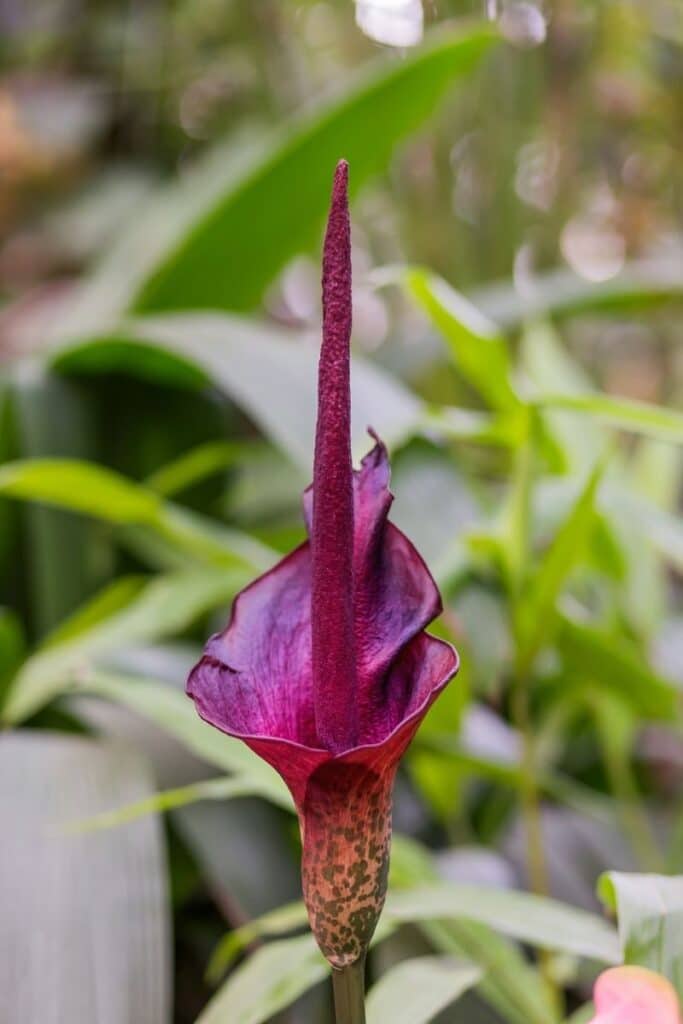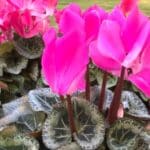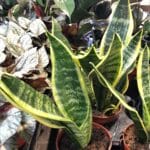If you’re looking for a large and interesting houseplant, the Voodoo lily should get your attention. It is a strange but fascinating plant, just as its name would suggest. This species can make a wonderful house plant but does have one drawback, the terrible but short-lived odor of its flower.
Read this article to learn everything you need to know about growing this large lily indoors.
Amorphophallus konjac is a perennial with an interesting lifecycle. This plant grows from a bulb-like structure known as a tuber, producing first a flower, then a large compound leaf, and then returning to dormancy. At an age of about 5 years, the voodoo lily bulb will be large enough to begin flowering.
The single flower is large and grows from a stalk up to 4 feet tall. The effect is quite striking, but unfortunately, this corpse flower smells terrible for a day or two! The reason for this is that the plant is fly-pollinated, and develops this smell to attract these insects.
Many growers would be surprised to know that the tree-like stem and leaves of this plant consist entirely of a single leaf. This leaf has a beautiful spotted petiole and an umbrella-shaped growth form.
Plant Facts
| Scientific name | Amorphophallus konjac, A. rivieri |
| Common names | Voodoo lily, devil’s tongue, umbrella arum, konjac, snake palm, stink lily, snake’s tongue |
| Family | Araceae |
| Plant Type | Houseplant |
| Height and Width | 4–6 ft. tall (indoors), 1–4 ft. wide (indoors) |
| Origin | Southeast Asia in Vietnam, China, Indonesia, Japan |
| Flower colors | Maroon, Purple |
| Foliage color | Deep green |
| Sun Exposure | Partial sun, Bright indirect sunlight |
| Soil Type & pH | Fertile, well-drained soil |
| Special features | Unusual plant, Large flower |
How to Grow a Voodoo Lily
The voodoo lily plant can be grown both outdoors in beds or containers, and indoors as a houseplant. It generally provides interest from early spring when it flowers to early fall when it goes into dormancy. Read on for specific information on how to grow this plant indoors.
Propagation
Voodoo lilies can be grown from seeds, but unfortunately, these can be hard to find or produce from your plants. Luckily, healthy voodoo lilies will produce multiple new tubers, so you should have no problem growing your voodoo lily collection each year!
The new tubers can be separated from the parent in spring, or you can wait for them to detach themselves. Whenever repotting these voodoo lily plants, be sure to search through the soil; you might be surprised at how many new plants you’ll find.
Soil
A good quality potting mix soil may be adequate, but since these exotic plants require very well-drained, organic soil, a succulent mix would probably be better. These plants are heavy feeders that prefer a rich growing medium, so select a product that contains some organic compost and peat moss.
If you would like to improve the drainage of your soil, you can mix in about 25% perlite or grit. One thing to bear in mind when using a perlite-rich soil is that these plants can get somewhat top-heavy, so use a heavy pot, or find a way to stabilize the container to prevent it from tipping over.
To ensure that the soil surface remains moist, water the plant thoroughly and allow the water to drain out of the pot. Then, place the pot on a saucer filled with water and let the soil surface absorb the water from the bottom. This will help the plant to grow healthy and strong.
Pruning
The voodoo lily plant will begin to flower each year once its tuber has grown to a size of about 4 inches (10cm) across. Growing to such a size can take several years, however. At this point, the plant will produce a single flower spike in the late winter to spring, which is then replaced by a new leaf about a month later.
Surprisingly, the stem and leaves of the Voodoo lily are actually all a single, complex leaf. This leaf should not be pruned as this will damage the plant.
The leaf only survives for a single season and will die back by late summer to fall. Both the leaf and the flower stalk can be removed once they have dried up.
Repotting and Transplanting
The voodoo lily goes through a dormant period each year, and this is the obvious time for repotting. In fact, once the dormant period has begun, many growers will dig up the tubers and store them in a dry place until they start producing the first sign of the flower stalk in the late winter.
Storing them over winter isn’t absolutely necessary, it is simply a safeguard against rot during the dormant period. If you do go this route, allow the tuber to reabsorb most of the nutrients and moisture from the wilting leaf before removing it.
Store the tubers in a paper bag in a cool, dark location. Keep them dry, and avoid storing them in plastic as this causes rot.
Voodoo Lily Care Guide
Once you have an established specimen, you should have no problem caring for these interesting tropical plants. Read on for more specific care information.
Water
Voodoo lilies appreciate a moist growing medium but should never be kept in saturated soil as this can result in root rot. This is where the importance of a well-drained medium becomes evident. These tropical plants should only be watered during the active growing season, so allow the soil to dry out completely if you plan on overwintering the tuber in its soil.
Sunlight
These pollinated flowers can be grown in a fairly wide range of lighting conditions, although they will do best when allowed access to some direct sunlight. They might be able to handle full sun as long as you keep them out of the direct afternoon sun.
They should, however, be grown in mostly bright, indirect light as too much direct sunlight can burn young foliage.
Temperature and Humidity
The voodoo lily is a tropical plant that enjoys a warm, humid environment. They can be grown in relatively cool climates, however, especially as a houseplant because they enter dormancy during the winter season. The dormant tubers do not need to be kept at tropical temperatures but should be protected from freezing conditions.
Fertilizer
These plants do best when allowed access to plenty of nutrients, so use a fertilizer of your choice throughout the plant growing season. When the leaf begins to die back and be reabsorbed by the tuber, it’s time to stop fertilizing.
Pest and diseases
This plant tends to be disease and pest-resistant. Avoid overwatering as this could cause rot, and limit the plant’s exposure to direct sunlight to avoid burning of the foliage.
Common Varieties and Cultivars
There are a few different forms of this plant that are available from time to time. These plants differ mostly in the color of the leaf petiole and the leaflets. Some examples include:
- ‘Leo Song’
- ‘Flesh Gordon’
- Gordon’s Gold’
- ‘Nightstick’
FAQs
Is A voodoo lily rare?
The term “voodoo lily” is used for several different plant species, and their rarity can vary. One common voodoo lily is the Sauromatum venosum, which is not considered rare and is cultivated by plant enthusiasts.
Does voodoo lily smell?
Yes, many voodoo lilies, including the Sauromatum venosum, produce a strong and unpleasant odor. The scent is often likened to that of a rotting animal, which attracts flies as natural pollinators.
Are voodoo lilies poisonous?
Voodoo lilies like Sauromatum venosum are generally not considered highly toxic to humans. However, they may contain compounds that can cause mild irritation if ingested, so it’s advisable to handle them with care and keep them away from pets and small children.
Can you grow voodoo lily indoors?
Yes, Voodoo lilies can be grown indoors, but they require specific care. Provide well-draining soil, adequate moisture during the growing season, and a period of dormancy with reduced watering in the winter. Ensure the indoor environment receives enough light to support their growth.
Why do voodoo lilies stink?
The strong odor emitted by voodoo lilies, especially during their flowering stage, serves to attract carrion flies and beetles, which act as pollinators. The smell mimics that of decaying flesh, a strategy evolved by the plant to ensure successful pollination by these specific insects.
Conclusion
The voodoo lily is a remarkable plant that makes a bold statement in the indoor environment. Growing this plant through its various growth stages will fascinate you. You’ll just have to put up with one very smelly voodoo lily bloom for a few days each year.
*image by aksenovko/depositphotos







